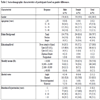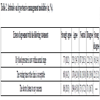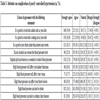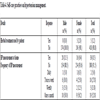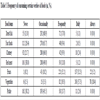- Home
- About Journals
-
Information for Authors/ReviewersEditorial Policies
Publication Fee
Publication Cycle - Process Flowchart
Online Manuscript Submission and Tracking System
Publishing Ethics and Rectitude
Authorship
Author Benefits
Reviewer Guidelines
Guest Editor Guidelines
Peer Review Workflow
Quick Track Option
Copyediting Services
Bentham Open Membership
Bentham Open Advisory Board
Archiving Policies
Fabricating and Stating False Information
Post Publication Discussions and Corrections
Editorial Management
Advertise With Us
Funding Agencies
Rate List
Kudos
General FAQs
Special Fee Waivers and Discounts
- Contact
- Help
- About Us
- Search

The Open Hypertension Journal
(Discontinued)
ISSN: 1876-5262 ― Volume 12, 2020
Perceptions, Attitudes and Self-care Practices on Management of Hypertension Among Hypertensive Patients at Teaching Hospital, Batticaloa District, Sri Lanka
G Kisokanth1, *, Ilankoon IMPS2, Arulanandem K3, Sundaresan KT4, Goonewardena CSE5, Joseph J1
Abstract
Objective:
Hypertension is an important public health challenge in both developing and developed countries. It is one of the commonest causes of death in Sri Lanka. The patients’ perception, beliefs and attitudes about management of hypertension have an independent effect on patients’ compliance in adapting their lifestyle behaviors. Thus, the purpose of this study was to describe the adapting self-care practices, attitudes among patients with hypertension.
Methods:
The cross sectional descriptive study was carried out among 424 hypertensive patients attending medical clinics, Teaching Hospital, Batticaloa, Sri Lanka. Systematic sampling technique was used to select participants. Interviewer administered questionnaire was used to collect the information and descriptive statistics was applied using SPSS software. Ethical clearance was obtained.
Results:
Majority was females (59%) and the mean age of the participants was 60.4 years (SD± 9.6) with 1-5 years duration. More than 65% of patients agreed that ‘Doctors listen and concern their problems’. More than half of the participants also agreed that ‘Doctors clearly explain their condition’ while majority agreed that ‘I can manage my disease’. About 92.0% have reported that they have not checked their blood pressure at home. Majority of participants (88%) agreed that ‘Avoidance of extra salt in their diet is good’. About 33.0% disagreed that ‘Regular physical exercise is essential to control blood pressure’. About 24.0% of participants disagreed that it is ‘Good to have fruits than deserts and sweets’ while less than 40.0% participants disagreed that ‘high blood pressure affects kidney functions, vision, blood vessels, and lead to stroke and ischemic heart disease’.
Conclusion:
Majority of the hypertensive patients believe that Doctors understand and concern about their disease and have also developed confidence in self-care. Though, creating a short clinic appointment with adequate knowledge need to be encouraged for their adapting self-practices on factors related to patients and physicians .
Article Information
Identifiers and Pagination:
Year: 2018Volume: 10
First Page: 1
Last Page: 7
Publisher Id: TOHYPERJ-10-1
DOI: 10.2174/1876526201810010001
Article History:
Received Date: 18/08/2017Revision Received Date: 20/12/2017
Acceptance Date: 31/12/2017
Electronic publication date: 25/01/2018
Collection year: 2018
open-access license: This is an open access article distributed under the terms of the Creative Commons Attribution 4.0 International Public License (CC-BY 4.0), a copy of which is available at: https://creativecommons.org/licenses/by/4.0/legalcode. This license permits unrestricted use, distribution, and reproduction in any medium, provided the original author and source are credited.
* Address correspondence to this author at the Department of Supplementary Health Sciences, Faculty of Health Care Sciences, Eastern University, Chenkaladi, Sri Lanka; Tel: +94 772228330; E-mail: kiso.1983@yahoo.com
| Open Peer Review Details | |||
|---|---|---|---|
| Manuscript submitted on 18-08-2017 |
Original Manuscript | Perceptions, Attitudes and Self-care Practices on Management of Hypertension Among Hypertensive Patients at Teaching Hospital, Batticaloa District, Sri Lanka | |
1. INTRODUCTION
Hypertension is an important public health challenge in both developing and developed countries [1Kishore J, Gupta N, Kohli C, Kumar N. Prevalence of hypertension and determination of its risk factors in rural delhi. Int J Hypertens 2016; 6.
[http://dx.doi.org/10.1155/2016/7962595] ]. Hypertension is one of the commonest causes of death in Sri Lanka [2Kumanan T, Guruparan M, Mohideen MR. Non-adherence of antihypertensive therapy: A serious public health issue in Sri Lanka. J Ceylon College Physicians 2016; 47: 50-1.
[http://dx.doi.org/10.4038/jccp.v47i1.7772] ]. According to Katulanda et al (2009), around one-third Sri Lankan adults over 20 years suffer from hypertension with the prevalence of 27.8% and 30.7% in rural and urban respectively [3Katulanda P, De Vas Gunawardena AN, Constantine GR, Sheriff MH, Matthews DR. Prevalence and correlates of hypertension in Sri Lanka. Ceylon College of Physicians - 42nd Annual Academic Sessions2009. Available from: http://archive.cmb.ac.lk:8080/research/handle/70130/1897]. Further, the age standardized prevalence rate for hypertension for men was 18.8% and 19.3% for women in Sri Lanka [4Wijewardene K, Mohideen MR, Mendis S, et al. Prevalence of hypertension, diabetes and obesity: Baseline findings of a population based survey in four provinces in Sri Lanka. Ceylon Med J 2005; 50(2): 62-70.
[http://dx.doi.org/10.4038/cmj.v50i2.1571] [PMID: 16114771] ]. The overall global prevalence among adults was 26.6% in men and 26.1% in women [5Kearney PM, Whelton M, Reynolds K, Whelton PK, He J. Worldwide prevalence of hypertension: A systematic review. J Hypertens 2004; 22(1): 11-9.
[http://dx.doi.org/10.1097/00004872-200401000-00003] [PMID: 15106785] ] while the world health statistics report in 2014 has stated that prevalence rate for hypertension in Sri Lanka for men and women were 21.6%, 20.8% respectively [6World Health Statistic report, A wealth of information on global public health 2014. Available from: http://apps.who.int/iris/bitstream/10665/112739/1/WHO_HIS_HSI_14.1_eng.pdf?ua=1].
Increasing awareness on treatment of hypertension is one of the main focuses of primary prevention of cardiovascular diseases (CVDs). The patients’ beliefs and attitudes about management of hypertension have an independent effect on patients’ compliance on recommended lifestyle behaviors [7Heymann AD, Gross R, Tabenkin H, Porter B, Porath A. Factors associated with hypertensive patients’ compliance with recommended lifestyle behaviors. Isr Med Assoc J 2011; 13(9): 553-7.
[PMID: 21991716] ].
Hypertension itself is a major risk factor for stroke and coronary heart disease as well as for the progression of chronic heart and kidney failures. Worldwide, around 54% of stroke and 47% of ischemic heart diseases were attributable to high blood pressure [8Lawes CM, Vander Hoorn S, Rodgers A. Global burden of blood-pressure-related disease, 2001. Lancet 2008; 371(9623): 1513-8.
[http://dx.doi.org/10.1016/S0140-6736(08)60655-8] [PMID: 18456100] ]. Nearly, 7.6 million premature deaths (about 13.5% of the global total) were attributed to high blood pressure itself. The people of South Asian descent have one of the highest risks of CVDs in the world [9Khan MS, Jafary FH, Jafar TH, et al. Knowledge of modifiable risk factors of heart disease among patients with acute myocardial infarction in Karachi, Pakistan: A cross sectional study. BMC Cardiovasc Disord 2006; 6(18): 18.
[http://dx.doi.org/10.1186/1471-2261-6-18] [PMID: 16643643] ] and failure in achieving the targeted Blood Pressure (BP) control is also a global problem [10Degli Esposti E, Di Martino M, Sturani A, et al. Risk factors for uncontrolled hypertension in Italy. J Hum Hypertens 2004; 18(3): 207-13.
[http://dx.doi.org/10.1038/sj.jhh.1001656] [PMID: 14973516] ]. The non-pharmacological treatment (smoking cessation, weight reduction, proper diet and regular physical activity) is an integral and crucial element in controlling BP [7Heymann AD, Gross R, Tabenkin H, Porter B, Porath A. Factors associated with hypertensive patients’ compliance with recommended lifestyle behaviors. Isr Med Assoc J 2011; 13(9): 553-7.
[PMID: 21991716] , 11Huang N, Duggan K. Lifestyle management of hypertension. Aust Prescr 2008; 31: 150-3.
[http://dx.doi.org/10.18773/austprescr.2008.085] ].
The factors associated with inadequate BP control could be either due to patient or physician related factors. Thus, the purpose of this study was to describe the adapting self-care practices, attitudes among patients with hypertension attending medical clinics, Teaching Hospital, Batticaloa, Sri Lanka. The outcome of the study might help to identify strategies to improve blood pressure control among hypertensive patients.
2. METHODOLOGY
The cross sectional descriptive study was carried out among hypertensive patients at medical clinics of Teaching Hospital, Batticaloa. Both male and female patients of age 18 years and above who were diagnosed as essential hypertension attending the medical clinics were included. Patients who were critically ill, cognitively impaired were excluded.
The extensive literature search has revealed that studies on attitudes and reported self-care practices among patients with hypertension in the region of Batticaloa has not been reported or published. The maximum sample size was obtained for a given margin of error (d) 0.05 with the prevalence of any of the characteristics taken as 50%. The calculated sample size was 384 and this number was inflated by another 10% to account for non-respondents. Thus, the final sample size was 424.
Systematic sampling technique was used to select the participants from the medical clinics at Teaching Hospital, Batticaloa. Interviewer administered questionnaire was used which was designed based on an extensive literature review of similar studies and focusing the objective of the study. Initially, it was prepared in English and translated to Tamil and again retranslated to English to ensure the accuracy. This questionnaire was pretested on 10 hypertensive patients who were fitting with inclusion criteria, and were not included in the final study sample. The final questionnaire was modified based on the results of the pre-testing of the questionnaire.
Participation for the study was strictly on voluntary basis and informed written consent was obtained prior to the study. The information sheet had included the details of their part in it, how privacy is maintained, and their right to refuse. Anonymity and confidentiality of the information were maintained through a code number for the participants. Accessibility to all the data collected was limited to the investigators only.
Ethical clearance was obtained from the Ethical Review Committee, Faculty of Health Care-sciences, Eastern University, Sri Lanka, prior to the commencement of the study. Verbal permission was obtained from Director and consultant physicians of relevant medical clinics of Teaching Hospital, Batticaloa
Data were entered in to Statistical Package for Social Sciences (SPSS) software version 21, and checked twice by the investigators. Descriptive statistics was applied to obtain percentage and mean and relevant inferential statistics was performed.
3. RESULTS
3.1. Sociodemographic Characteristics
Total of 424 hypertensive patients were examined and among them, 250 (59.0%) were females. Majority of participants (71.4%) were in the age group of 51-70 years. The mean age of them was 60.4 years (SD± 9.6) [61.2 years (± 9.1) for men and 59.8 years (±9.8) for women]. Two hundred and sixty participants (61.3%) were studied up to GCE Ordinary Level. About half of the participants (47.6%) were either unemployed or unskilled. A significant majority of participants (91.3%) were living with an extended family system. Nearly 46% of participants had hypertension for 1 to 5 years of duration. Fifty seven percent have revealed that source of information on hypertension was obtained from the clinic (Health care provider) while only 2% of participants had obtained from friends or relatives. The socio- demographics details are shown in Table 1.
3.2. Attitudes About Management of Hypertension
Around 55.0% of participants agreed that their blood pressure is within normal range. Forty six percent have agreed with the statement that ‘doctor listens their concerns at clinic’. Around 57.0% of participants agreed with the statement of ‘doctor clearly explains my condition’. One in ten participants disagreed with the statement of ‘availability of relevant medication’. About 24.0% of participants were not aware that including green leafy vegetable in their daily diet would help to improve hypertension. Approximately 5.0% have disagreed with the statement that ‘they do not have the ability to manage their hypertension’ (Table 2).
Eighty eight percent agreed with statement of ‘avoidance of extra salt in their diet is good’ for better hypertensive management. About 24.0% of them disagreed the statement of ‘it is good to have fruits than deserts and sweets’. About 33.0% disagreed that regular physical exercise is essential to control blood pressure. Further, around less than 40.0% of participants disagreed with the statement of ‘high blood pressure affects kidney functions, vision, blood vessels, lead to stroke and ischemic heart disease (Table 3).
3.3. Reported Practices Towards Management of Hypertension
Few of them (1.2%) mentioned that in addition to western medicine, they use other treatment methods such as Ayurveda or herbal treatment. About 92.0% have reported that they have not checked their blood pressure at home at all. Among those who checked, 52.8% of them had checked once a month (Table 4).
Majority of the participants consume vegetables and fruits either occasionally or frequently while about 45.0% of participants consume pickle occasionally (Table 5).
4. DISCUSSION
In this study, hypertension was observed predominantly among females than in males. Similar observation was seen in a study where females were more among the hypertensive patients [12Iyalomhe GB, Iyalomhe SI. Hypertension-related knowledge, attitudes and life-style practices among hypertensive patients in a sub-urban Nigerian community. J Public Health Epidemiol 2010; 2(4): 71-7.]. The participants in the age group of 51-70 years, unskilled employment status and educational qualification of up to GCE O/L were the other predominant categories. Similarly, Mahajan et al (2012) study had revealed that, majority of participants were either unemployed or unskilled [13Mahajan H, Kazi Y, Sharma B, Velhal GD. Assessment of KAP, risk factors and associated co-morbidities in hypertensive patients. J Dent Med Sci 2012; 1(2): 6-14.
[http://dx.doi.org/10.9790/0853-0120614] ]. More than half of participants had the monthly income of less than Rs. 10, 000. Thus, the findings suggest that there is a strong influence of low income and lower educational level on poor hypertension outcomes. This is evidenced by ignorance and lack of relevant knowledge or skills required to maintain quality hypertensive care and control. Majority of participants (91.3%) were living with an extended family system in this study population and that was supported in a study [9Khan MS, Jafary FH, Jafar TH, et al. Knowledge of modifiable risk factors of heart disease among patients with acute myocardial infarction in Karachi, Pakistan: A cross sectional study. BMC Cardiovasc Disord 2006; 6(18): 18.
[http://dx.doi.org/10.1186/1471-2261-6-18] [PMID: 16643643] ]. But, living in an extended family system may lead to exposure and reinforcement of traditional and potentially unhealthy health practices and beliefs [14Masmas TN, Jensen H, da Silva D, Høj L, Sandström A, Aaby P. The social situation of motherless children in rural and urban areas of Guinea-Bissau. Soc Sci Med 2004; 59(6): 1231-9.
[http://dx.doi.org/10.1016/j.socscimed.2003.12.012] [PMID: 15210094] ].
Majority of the participants in this study agreed with the statements of “Doctor listens and understands their concerns at clinic” and “Doctor clearly explains their condition”. Thomson et al. (2001) have suggested that health-care professionals should promote patients’ knowledge, correct perception, beliefs and attitude towards management of hypertension through sufficient explanation of the nature, consequences and management of the disease [15Thomson R, Bowling A, Moss F. Engaging patients in decisions: A challenge to health care delivery and public health. Qual Health Care 2001; 10(Suppl. 1): i1.
[PMID: 11533429] ]. In a developing country like Sri Lanka, a relative shortage of medical manpower and an overwhelming burden of communicable diseases have led to inadequate time and contact with patients. However, there should be concentrated efforts to improve. But, it is advisable to provide adequate knowledge to patients through provision of a short clinic appointment to create more contact with health care providers.
In this study, majority of participants believed that tablets and lifestyle modifications (exercise and diet therapy) were the useful strategies for controlling hypertension. It was evident that lifestyle modification is an effective public health tool for successful treatment and control of hypertension [16Mancia G, Groppelli A, Casadei R, Omboni S, Mutti E, Parati G. Cardiovascular effects of smoking. Clin Exp Hypertens A 1990; 12(5): 917-29.
[http://dx.doi.org/10.3109/10641969009073509] [PMID: 2208758] , 17Stewart KJ, Bacher AC, Turner KL, et al. Effects of exercise on blood pressure. Arch Intern Med 2005; 165: 756-62.
[http://dx.doi.org/10.1001/archinte.165.7.756] [PMID: 15824294] ]. Further, the European Society of Hypertension (ESH) and the European Society of Cardiology (ESC) guideline in 2013 clearly stated that appropriate lifestyle changes are the cornerstone for the prevention of hypertension. In addition, lifestyle changes may safely and effectively delay or prevent medical therapy in hypertensive patients and contribute to BP reduction already on medical therapy [18Mancia G, Fagard R, Narkiewicz K, et al. ESH/ESC Guidelines for the management of arterial hypertension: The Task Force for the management of arterial hypertension of the European Society of Hypertension (ESH) and of the European Society of Cardiology (ESC). Eur Heart J 2013; 34(28): 2159-219.
[http://dx.doi.org/10.1093/eurheartj/eht151] [PMID: 23771844] ]. Furthermore, the updated guideline of American College of Cardiology (ACC)/ American Heart Association emphasizes that non-pharmacologic therapy (lifestyle changes) alone is especially useful for management of hypertension [19Guideline for the Prevention, Detection, Evaluation, and Management of High Blood Pressure in Adults. Hypertension 2017. [https://doi.org/10.1161/HYP.0000000000000065].].
Most of participants (92%) reported that they have not checked their blood pressure at home. This may be due to unavailability of blood pressure apparatus at home or inadequate knowledge on measurement of blood pressure. In this study, it was found that currently few percent of male participants were smoking and consuming alcohol. But in contrast, it was found that tobacco and alcohol consumption in any form was found high among hypertensive patients [13Mahajan H, Kazi Y, Sharma B, Velhal GD. Assessment of KAP, risk factors and associated co-morbidities in hypertensive patients. J Dent Med Sci 2012; 1(2): 6-14.
[http://dx.doi.org/10.9790/0853-0120614] ]. This finding is not correlated with our findings as the results were obtained subjectively. Further, in this study, more than half of participants were with Body Mass Index (BMI) above the normal range. According to the evidence, overweight was associated with a 2 fold to 6 fold increase in the risk of developing hypertension [13Mahajan H, Kazi Y, Sharma B, Velhal GD. Assessment of KAP, risk factors and associated co-morbidities in hypertensive patients. J Dent Med Sci 2012; 1(2): 6-14.
[http://dx.doi.org/10.9790/0853-0120614] ]. It was also shown that BMI amongst hypertensive patients were high [20Anand MP. Prevalence and grades of hypertension amongst executives of Mumbi. J Assoc Phys Ind 2008; 48(12): 1200-1., 21Malhotra P, Kumari S, Kumar R, Jain S, Sharma BK. Prevalence and determinants of hypertension in an un-industrialised rural population of North India. J Hum Hypertens 1999; 13(7): 467-72.
[http://dx.doi.org/10.1038/sj.jhh.1000864] [PMID: 10449211] ].
CONCLUSION
Home blood pressure monitoring seems to be very minimal among study participants. Majority of the hypertensive patients believe that Doctors understand and concern about their disease and have also developed confidence in self-care. Though, creating a short clinic appointment with adequate knowledge need to be encouraged for their adapting self-practices on factors related to patients and physicians.
ETHICS APPROVAL AND CONSENT TO PARTICIPATE
This study was approved by the Ethics Review Committee, Faculty of Health Care-Sciences, Eastern University, Sri-Lanka.
HUMAN AND ANIMAL RIGHTS:
Guideline for the Prevention, Detection, Evaluation, and Management of High Blood Pressure in Adults by American College of Cardiology/American Heart Association”
CONSENT FOR PUBLICATION
Informed written consent was obtained prior to the study.
CONFLICT OF INTEREST
The authors declare no conflict of interest, financial or otherwise.
ACKNOWLEDGEMENTS
The authors would like to thank all patients who participated in this study and respective Consultants, Nurse-In-charge, Medical Clinics, Teaching Hospital, Batticaloa.
REFERENCES
| [1] | Kishore J, Gupta N, Kohli C, Kumar N. Prevalence of hypertension and determination of its risk factors in rural delhi. Int J Hypertens 2016; 6. [http://dx.doi.org/10.1155/2016/7962595] |
| [2] | Kumanan T, Guruparan M, Mohideen MR. Non-adherence of antihypertensive therapy: A serious public health issue in Sri Lanka. J Ceylon College Physicians 2016; 47: 50-1. [http://dx.doi.org/10.4038/jccp.v47i1.7772] |
| [3] | Katulanda P, De Vas Gunawardena AN, Constantine GR, Sheriff MH, Matthews DR. Prevalence and correlates of hypertension in Sri Lanka. Ceylon College of Physicians - 42nd Annual Academic Sessions2009. Available from: http://archive.cmb.ac.lk:8080/research/handle/70130/1897 |
| [4] | Wijewardene K, Mohideen MR, Mendis S, et al. Prevalence of hypertension, diabetes and obesity: Baseline findings of a population based survey in four provinces in Sri Lanka. Ceylon Med J 2005; 50(2): 62-70. [http://dx.doi.org/10.4038/cmj.v50i2.1571] [PMID: 16114771] |
| [5] | Kearney PM, Whelton M, Reynolds K, Whelton PK, He J. Worldwide prevalence of hypertension: A systematic review. J Hypertens 2004; 22(1): 11-9. [http://dx.doi.org/10.1097/00004872-200401000-00003] [PMID: 15106785] |
| [6] | World Health Statistic report, A wealth of information on global public health 2014. Available from: http://apps.who.int/iris/bitstream/10665/112739/1/WHO_HIS_HSI_14.1_eng.pdf?ua=1 |
| [7] | Heymann AD, Gross R, Tabenkin H, Porter B, Porath A. Factors associated with hypertensive patients’ compliance with recommended lifestyle behaviors. Isr Med Assoc J 2011; 13(9): 553-7. [PMID: 21991716] |
| [8] | Lawes CM, Vander Hoorn S, Rodgers A. Global burden of blood-pressure-related disease, 2001. Lancet 2008; 371(9623): 1513-8. [http://dx.doi.org/10.1016/S0140-6736(08)60655-8] [PMID: 18456100] |
| [9] | Khan MS, Jafary FH, Jafar TH, et al. Knowledge of modifiable risk factors of heart disease among patients with acute myocardial infarction in Karachi, Pakistan: A cross sectional study. BMC Cardiovasc Disord 2006; 6(18): 18. [http://dx.doi.org/10.1186/1471-2261-6-18] [PMID: 16643643] |
| [10] | Degli Esposti E, Di Martino M, Sturani A, et al. Risk factors for uncontrolled hypertension in Italy. J Hum Hypertens 2004; 18(3): 207-13. [http://dx.doi.org/10.1038/sj.jhh.1001656] [PMID: 14973516] |
| [11] | Huang N, Duggan K. Lifestyle management of hypertension. Aust Prescr 2008; 31: 150-3. [http://dx.doi.org/10.18773/austprescr.2008.085] |
| [12] | Iyalomhe GB, Iyalomhe SI. Hypertension-related knowledge, attitudes and life-style practices among hypertensive patients in a sub-urban Nigerian community. J Public Health Epidemiol 2010; 2(4): 71-7. |
| [13] | Mahajan H, Kazi Y, Sharma B, Velhal GD. Assessment of KAP, risk factors and associated co-morbidities in hypertensive patients. J Dent Med Sci 2012; 1(2): 6-14. [http://dx.doi.org/10.9790/0853-0120614] |
| [14] | Masmas TN, Jensen H, da Silva D, Høj L, Sandström A, Aaby P. The social situation of motherless children in rural and urban areas of Guinea-Bissau. Soc Sci Med 2004; 59(6): 1231-9. [http://dx.doi.org/10.1016/j.socscimed.2003.12.012] [PMID: 15210094] |
| [15] | Thomson R, Bowling A, Moss F. Engaging patients in decisions: A challenge to health care delivery and public health. Qual Health Care 2001; 10(Suppl. 1): i1. [PMID: 11533429] |
| [16] | Mancia G, Groppelli A, Casadei R, Omboni S, Mutti E, Parati G. Cardiovascular effects of smoking. Clin Exp Hypertens A 1990; 12(5): 917-29. [http://dx.doi.org/10.3109/10641969009073509] [PMID: 2208758] |
| [17] | Stewart KJ, Bacher AC, Turner KL, et al. Effects of exercise on blood pressure. Arch Intern Med 2005; 165: 756-62. [http://dx.doi.org/10.1001/archinte.165.7.756] [PMID: 15824294] |
| [18] | Mancia G, Fagard R, Narkiewicz K, et al. ESH/ESC Guidelines for the management of arterial hypertension: The Task Force for the management of arterial hypertension of the European Society of Hypertension (ESH) and of the European Society of Cardiology (ESC). Eur Heart J 2013; 34(28): 2159-219. [http://dx.doi.org/10.1093/eurheartj/eht151] [PMID: 23771844] |
| [19] | Guideline for the Prevention, Detection, Evaluation, and Management of High Blood Pressure in Adults. Hypertension 2017. [https://doi.org/10.1161/HYP.0000000000000065]. |
| [20] | Anand MP. Prevalence and grades of hypertension amongst executives of Mumbi. J Assoc Phys Ind 2008; 48(12): 1200-1. |
| [21] | Malhotra P, Kumari S, Kumar R, Jain S, Sharma BK. Prevalence and determinants of hypertension in an un-industrialised rural population of North India. J Hum Hypertens 1999; 13(7): 467-72. [http://dx.doi.org/10.1038/sj.jhh.1000864] [PMID: 10449211] |




